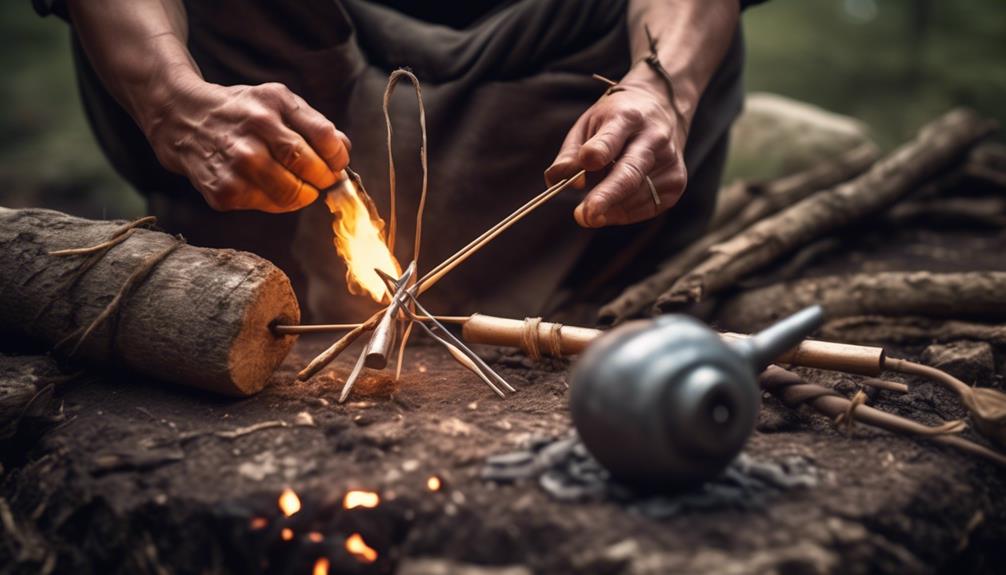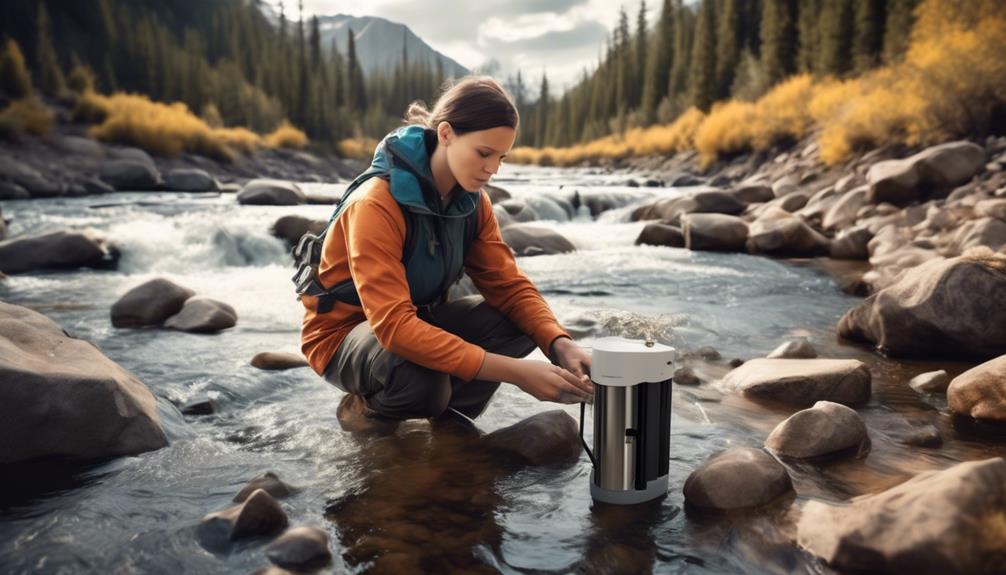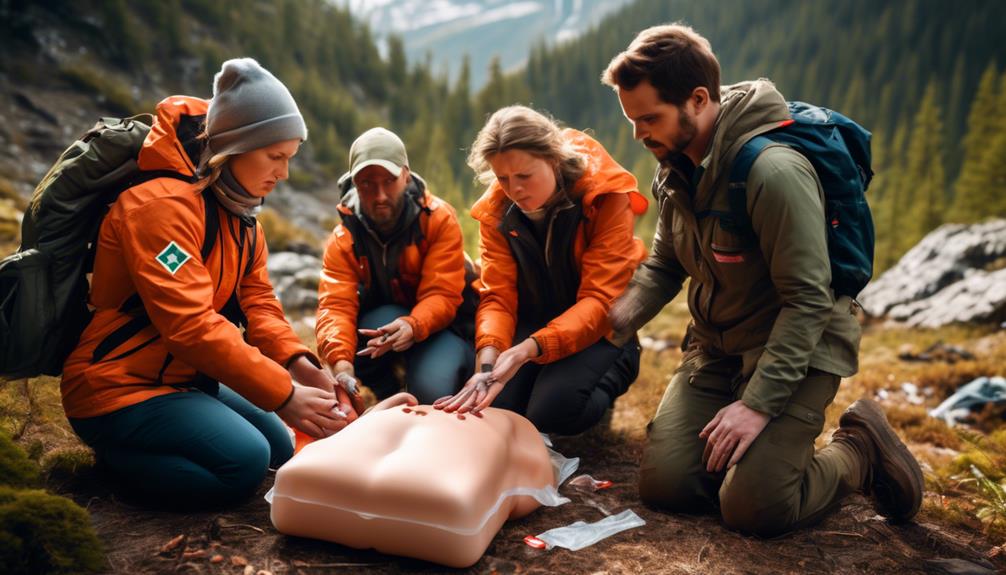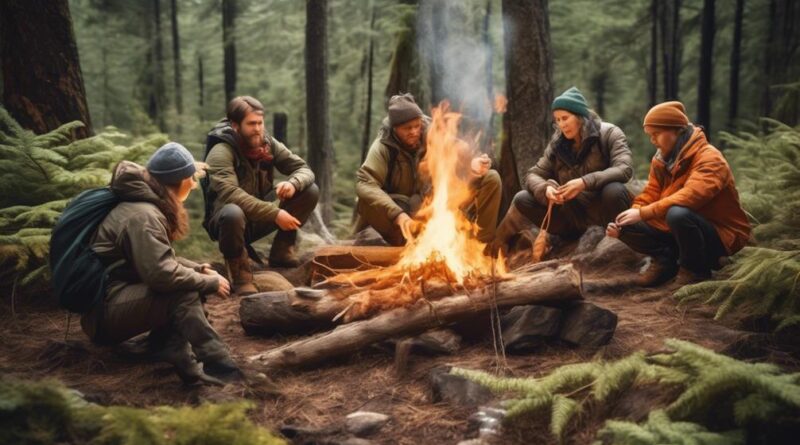What Are the Best Off-Grid Survival Training Holidays?
Looking to disconnect from the hustle and bustle of everyday life?
Did you know that the interest in off-grid survival training holidays has increased by 35% in the past five years?
Imagine immersing yourself in the wilderness, learning essential survival skills, and truly unplugging from modern conveniences.
But with so many options available, how do you know which off-grid survival training holidays are the best?
Wilderness Survival Skills
To survive in the wilderness, you need to master essential skills such as building shelter, finding clean water, and starting a fire. When venturing into the great outdoors, having the right survival equipment is crucial for your wilderness camping experience. Proper gear can make the difference between a challenging ordeal and a successful adventure.
First and foremost, having a reliable shelter is vital for wilderness survival. Packing a lightweight, waterproof tent or tarp can protect you from the elements and provide a safe haven. Additionally, knowing how to construct a shelter using natural materials such as branches, leaves, and debris is an invaluable skill if you find yourself without your camping gear.
Next, finding clean water is essential for your well-being. Carrying a portable water filtration system or purification tablets can help ensure a safe drinking supply. However, knowing how to locate and collect water from natural sources such as streams, rivers, or even dew on plants is a fundamental skill for any wilderness camper.
Primitive Shelter Building
Mastering primitive shelter building is a crucial skill for wilderness survival and an essential pivot from the previous subtopic of wilderness survival skills. When it comes to building a shelter in the wild, using natural materials and understanding survival techniques is imperative. Here's how to effectively build a primitive shelter:
- Natural Materials: Utilize resources found in the environment such as branches, leaves, and mud to construct a sturdy and weather-resistant shelter. Understanding the properties of different natural materials will help you build a functional shelter that provides protection from the elements.
- Survival Techniques: Learning survival techniques such as how to tie strong knots, weave materials together, and create a sturdy framework is essential for building a reliable primitive shelter. These techniques will enable you to construct a shelter that can withstand harsh weather conditions and provide a safe refuge.
- Adaptability: One of the key aspects of primitive shelter building is the ability to adapt to different environments and conditions. Understanding how to utilize natural materials in various landscapes and climates is crucial for effective shelter construction.
- Resourcefulness: Building a primitive shelter requires resourcefulness and creativity. You must be able to assess your surroundings and make the most of the available materials to create a shelter that meets your immediate needs.
Fire Making Techniques

You can enhance your wilderness survival skills by mastering various fire making techniques using natural resources found in the environment. One of the most traditional methods is the friction fire, which involves using a bow drill. This technique requires skill and patience as it involves rotating a wooden drill against a wooden base with the help of a bow, creating friction and eventually igniting a fire. Mastering the bow drill technique can be immensely rewarding but requires practice.
Another effective method is using flint and steel to create a spark that can ignite dry tinder. This technique is reliable and can be a lifesaver in damp conditions. Additionally, the fire plow method involves using a hardwood stick to create friction along a groove in a softer wood base, generating enough heat to ignite the tinder.
Learning these fire making techniques not only provides you with essential survival skills but also connects you to ancient traditions and knowledge. It's important to remember that successful fire making in a survival situation often depends on the availability of dry tinder, kindling, and suitable wood. Therefore, it's crucial to understand the principles and techniques of fire making using natural resources.
Edible Plant Foraging
Edible plant foraging involves identifying and gathering safe wild vegetation for sustenance in the wilderness. When foraging for edible plants, it's crucial to prioritize safety and sustainability.
Here are some essential tips to help you with edible plant identification and sustainable foraging techniques:
- Educate Yourself: Before embarking on an edible plant foraging expedition, invest time in learning about the native flora in the area. Familiarize yourself with common edible plants as well as poisonous look-alikes. Consider taking a foraging course or going on a guided foraging tour to gain hands-on experience and knowledge from experts.
- Respect Nature: Practice sustainable foraging techniques by only harvesting a small percentage of any given plant population. Avoid damaging the roots or taking all the plants in a particular area. By doing so, you can ensure the continued growth and availability of these resources for future foragers and wildlife.
- Use Multiple Sources for Verification: When identifying edible plants, cross-reference information from multiple reliable sources such as guidebooks, apps, and expert foragers. This approach can help minimize the risk of misidentifying plants and consuming something harmful.
- Start with Easy-to-Identify Plants: As a beginner, start with easily identifiable plants such as dandelions, wild berries, and clover. Once you gain confidence in recognizing these species, gradually expand your foraging repertoire to include more diverse and complex plant species.
Water Sourcing and Purification

When venturing into the wilderness, ensuring a safe and clean water supply is paramount for your survival and well-being. In off-grid survival training, understanding water sourcing and purification methods is essential.
Rainwater harvesting can be a valuable technique in remote areas. Setting up a simple rainwater collection system using tarps or other materials can provide a sustainable water source. However, it's crucial to purify this water before consumption.
Filtration methods are vital for obtaining potable water. Learning how to construct a makeshift water filter using layers of charcoal, sand, and gravel can help remove impurities. Additionally, portable water filtration systems or purification tablets are indispensable tools for ensuring the safety of the water you consume. These methods are practical and can be crucial in survival situations.
Furthermore, understanding the landscape is important for sourcing water. Knowing where to find natural water sources such as streams, rivers, or natural springs is valuable knowledge. However, it's important to remember that even seemingly clean water sources can contain harmful bacteria and parasites. Therefore, having the skills to purify water effectively is non-negotiable.
In off-grid survival training, the ability to source and purify water is a fundamental skill. By mastering techniques such as rainwater harvesting and various filtration methods, you can ensure access to clean and safe drinking water, even in the most remote locations.
Navigation and Orienteering
Understanding how to navigate using a map and compass is an essential skill for surviving and finding your way in the wilderness. When you embark on off-grid survival training holidays, mastering compass skills and map reading techniques can make all the difference in ensuring your safety and successful navigation.
Here are some crucial tips to help you improve your navigation and orienteering abilities:
- Understanding Map Symbols: Familiarize yourself with the various symbols used on topographic maps to identify terrain features, vegetation, water sources, and man-made structures. This knowledge will aid in interpreting the landscape and planning your route effectively.
- Using a Compass Correctly: Learn how to use a compass to establish direction, orient the map, and navigate accurately. Understanding declination and how to adjust for it will prevent you from getting lost and help you navigate with precision.
- Terrain Association: Develop the skill of correlating map features with the actual terrain around you. By recognizing prominent landmarks and associating them with your map, you can maintain situational awareness and stay on course.
- Dead Reckoning: Practice estimating your position and direction of travel without the aid of landmarks. This technique involves keeping track of your pace count, direction of travel, and elapsed time to determine your approximate location on the map.
Emergency First Aid Training

During off-grid survival training holidays, mastering emergency first aid training is crucial for responding effectively to unforeseen medical situations in the wilderness. Basic wound care is an essential skill for treating cuts, scrapes, and burns that may occur during outdoor activities. Learning how to clean and dress wounds properly can prevent infections and promote faster healing.
Additionally, understanding emergency response procedures is vital for handling more serious injuries such as fractures or sprains that may happen in remote locations. This training equips you with the necessary knowledge to stabilize a person's condition until professional medical help can be reached.
Moreover, CPR and AED training are fundamental components of emergency first aid training. Knowing how to perform cardiopulmonary resuscitation (CPR) can mean the difference between life and death in the event of cardiac arrest. Automated External Defibrillator (AED) training is also crucial as it teaches you how to use this life-saving device to deliver an electric shock to the heart in cases of sudden cardiac arrest. These skills are particularly important when access to immediate medical assistance is limited.
Outdoor Survival Challenges
Facing outdoor survival challenges demands resourcefulness and adaptability in order to overcome obstacles and thrive in the wilderness. Whether you find yourself stranded in the woods or lost in the mountains, honing your outdoor survival skills is crucial. Here are some key aspects to consider when tackling outdoor survival challenges:
- Wilderness Navigation: Navigating through the wilderness without the aid of technology is a fundamental skill. Understanding how to use a map and compass, identifying natural landmarks, and interpreting the sun's position are essential techniques. Additionally, learning to navigate in low visibility conditions, such as fog or darkness, is vital for staying on course.
- Shelter Building: Constructing a shelter from natural materials can provide protection from the elements. Mastering the art of crafting a sturdy shelter, whether it's a lean-to, debris hut, or snow cave, is crucial for maintaining body temperature and staying dry.
- Fire Starting: Knowing how to start a fire without matches or a lighter is a critical survival skill. Learning various methods such as friction-based fire starting, using flint and steel, and creating fire plows can be invaluable in a survival situation.
- Survival Team Building: In a group survival scenario, effective teamwork is essential. Building trust, effective communication, and division of tasks among team members can significantly increase the chances of survival. Conducting regular team drills and fostering a strong team spirit are vital components of successful survival team building.
Mastering these outdoor survival challenges through proper training and practice will enhance your ability to thrive in the wilderness, no matter the circumstances.
Frequently Asked Questions
What Is the Instructor-To-Student Ratio During the Off-Grid Survival Training Holidays?
During off-grid survival training holidays, the instructor-to-student ratio is crucial. Ensure the instructors are highly qualified and that comprehensive safety protocols are in place. This ensures a safe and effective learning environment for all participants.
Are There Any Age Restrictions for Participants in These Training Holidays?
There are age restrictions for participants in these training holidays. You must meet the participant requirements, including a minimum age. Make sure to check the specific guidelines before signing up for the off-grid survival training.
What Type of Gear and Equipment Do Participants Need to Bring With Them for the Training?
You'll need essential gear and equipment for the survival skills training. Bring items like a sturdy backpack, multi-tool, water purification system, durable footwear, and weather-appropriate clothing. Proper gear is crucial for off-grid survival training.
Are There Any Specific Dietary Restrictions or Accommodations for Meals During the Training?
You should inform the organizers of any dietary restrictions beforehand. They can usually accommodate most needs, but it's important to communicate clearly to ensure meal accommodations meet your requirements during the training.
Is There a Minimum Level of Physical Fitness Required to Participate in the Training Holidays?
You should have a moderate level of physical fitness to participate in the training holidays. The training intensity may vary, but it's important to be prepared for activities that require stamina, strength, and endurance.
Conclusion
So, if you're looking for an adventurous and educational vacation, consider an off-grid survival training holiday.
You'll learn essential wilderness survival skills, from building shelters to foraging for food. Plus, you'll gain confidence in your ability to handle emergency situations.
It's a unique and exciting way to disconnect from the modern world and reconnect with nature.
So pack your bags and get ready for an unforgettable off-grid adventure!
